To be fair, one must approach judgement of a legendary and veteran band such as Sodom, with care, so that their present actions are seen in light of the road they have tread. In this spirit, it is appropriate that we go over the band’s career, taking a brief look at each step of their evolution so as to get a picture of how the band came to be as we see it and hear them today on Decision Day. If we are to start from the very beginning, we have to look back to their very first demo released in 1984, Victims of Death, which stands in an area between Metallica – Kill ‘Em All and Bathory’s self-titled debut album. Sodom’s first step is closer to contemporary hardcore punk than speed metal, which affords them a certain street credibility.
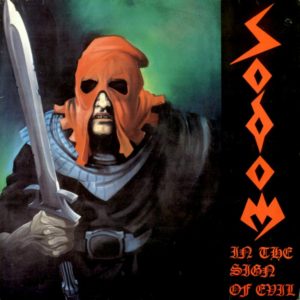

In the Sign of Evil (1984) and Obsessed by Cruelty (1986) follow suit, but providing a much more audible content, even if stilled heavily muffled. Here, Sodom rely on very extensive repetition, completely giving themselves in to the riff as lord and deity. It is as if nothing else existed, neither a next section nor a next thought. Each riff pattern is completely self-absorbed and taken to the limits of repetition. Exceptions consist in small rhythmic breaks which introduce what one could refer to as half-riffs, in smaller subsections that alternate several times with the main riff. The second half of the duet, Obsessed by Cruelty, sees Sodom introducing their more tempo-variable side, which, however, does not imply a discarding of their more forward expressions.
Bathory’s Bathory and The Return are perfect points of reference for this initial stage in Sodom’s musical career. The first Bathory seems perfectly in line with the precepts that Sodom’s earliest proposal appears to follow, but on The Return we observe how Quorthon takes Bathory a step further on the road of compositional refinement by attempting more linear structures that relate to each other through clear motifs. Sodom, on the contrary, seem to indulge in ingraining and making a part of the identity not only the brutality of the expression but the deepest cavemanish approach to songwriting, which emphasize the power of individual riffs and tying songs together with an incredibly minimalist narrowness of style rather than by narrative development.
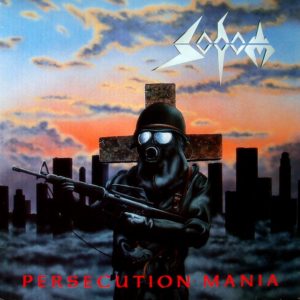
Persecution Mania (1987) sounds a bit closer to Kreator in the vocal department, which is completely understandable given the similarity of both bands in this early stage before the Big Sell Out. Here is the debut of the slightly bouncy and comic patterns in Sodom’s music, though used in very measured quantities. Also, the success of other leading underground metal acts affects the composition, showing a band that is always one or more steps behind genre refinement, and perhaps never acquiring an original voice. These are early signs already clearly visible in 1987 that are crucial in understanding the eventual fate suffered by Sodom at the hands of Time. Despite this, to Caesar what is Caesar’s: it must be acknowledged that Persecution Mania presents a more promising element of order and holistic vision that Sodom’s earlier productions lacked.
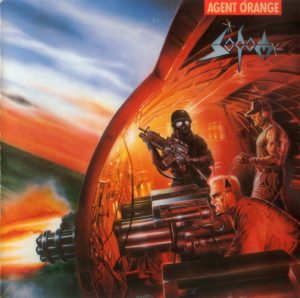
Agent Orange (1989) is superior to its predecessors both in the editor’s treatment of the material, what we know as an album’s production, in the possession of a more lucid structuring sense, and a noticeable improvement in musicianship. Agent Orange is also more content-dense, indulging less in straightforward repetition, avoiding randomness and presenting functional transitions between sections that follow each other through an emotional logic. Released in 1989, it is Sodom’s compilation of everything speed metal, or thrash metal as the masses of ignoramuses have come to know this punk-ized New Wave of British Heavy Metal. At times having overtones of Metallica or Megadeth, Sodom represents the gist and unpretentious side of the genre.
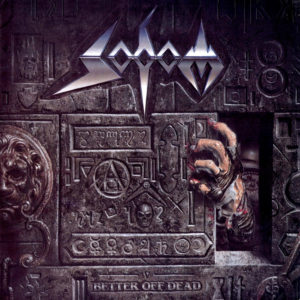
Better Off Dead (1990) is the first explicitly groovy album by the band. Lingering in a dubious zone between glam metal and the band’s own take on a genericized speed metal, Better Off Dead plays like a tired Metallica after selling out that for brief moments wants to be Sodom.
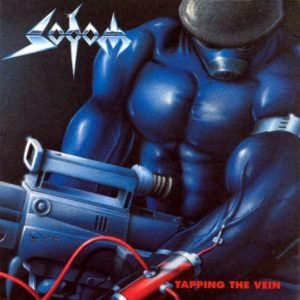
Tapping the Vein (1992) promises little more and more of the same. Tapping the Vein and Better Off Dead are both albums by an eighties speed metal band during the early nineties, indicating a particularly low probability that this is worth anyone’s time. They both play like increasingly desperate attempts at recreating a magic that is all but spent. Songwriting is random, structures cycle, and narrative is broken.
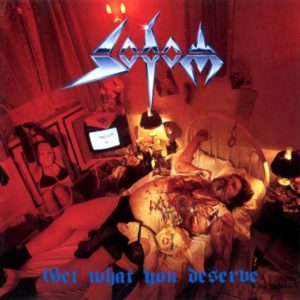
Get What You Deserve (1994) takes the aforementioned to the next level of frustration. Here, we find it difficult to find any trace of the Sodom from just five years before on Agent Orange. This is a band inadequately trying to simultaneously catch up with a movement they were never on time for and selling out through sounding even more generic than they already were. We find traces of trailer park pseudo speed death, embarrassing hard rock imitations, and a general apathy towards metal that only a forced label deal can motivate. This album is not only painful to listen to but also induces that feeling of embarrassment that we can experience as proxies for less perceptive victims and central actors in such comedies.
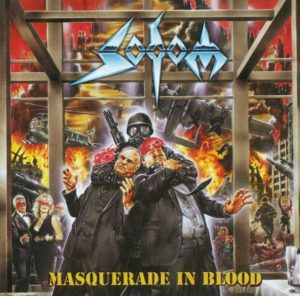
Masquerade in Blood (1995) takes the band to unprecedented levels of indecency and unabashed submission. Come the year 1995, Sodom sounds like a forerunner of Slipknot with about the same amount of balls as Gwar and the credibility of Limp Bizkit. The vocalist quite literally is on the verge of rapping, riffs groove or run and chug, as if in imitation of the contemporary “innovations” of Pantera. As if in a prophetic gesture, Sodom turns so empty and borrowing from the surface traits of so many places that it starts to rely on low-string rhythms, at times foreboding the rise of the incipient metalcore and future deathcore pseudo-metal pop-punk genres.
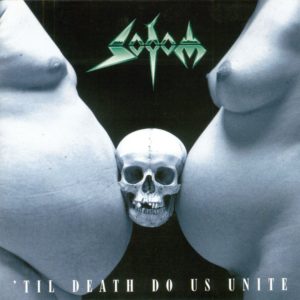
‘Til Death Do Us Unite (1997) sounds as retarded as the title gives away, but the silver lining that come with this huge, dark cloud of farted shit particles is that someone seems to have informed the band that nu-metal was a doomed idea without any value or merit. But Sodom had yet to get rid themselves of redneck-core attitudes and the acquired ninetiesisms. Some of the moments in this album are pure, unadulterated alternative pseudo-speed pop heavy rock constructions organized around spoken and rapped vocals.
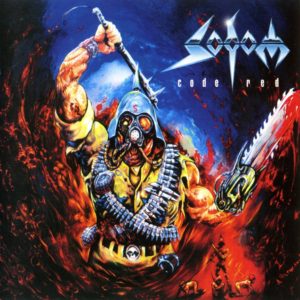
Code Red (1999) is again for all intents and purposes, an extension of their previous effort. In retrospect, we start to see a pattern in the way Sodom decides its musical direction, always one step behind developments, and almost always delivering second grade imitations of someone else’s idea, filtered through stale trademark Sodom speed metal. This is, in fact, Metallica-grade pathetic.
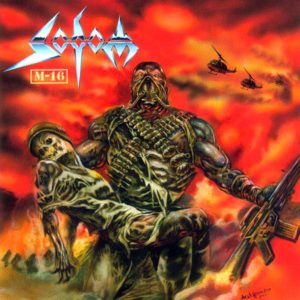
M-16 (2001) is the first album by Sodom in the twenty first century. A change in the band’s attitude is perceptible right off the bat, with a standard heavy metal marching build up, followed by a still bouncy but more purely speed metal delivery. This is Nu Sodom, with a preponderance of one, two, one, two rhythmic silliness and throwback riffs that remind us and the band of a time when they were almost good. M-16 gives us a tired Sodom, a Sodom trying to get back on its horse, not quite doing it, and instead jumping around on a toy stick horse pretending to be back in the game.
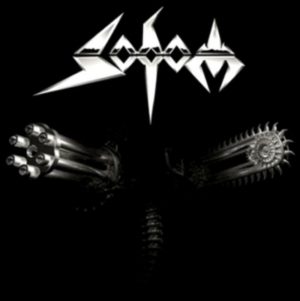
Sodom (2006), the sign of a band going through middle life crisis, attempting to redefine or reformulate itself through the decades-late imposition of a generic eponymous on an unsuspecting audience always hungry for the illusion of hope supplied by a fallen hero. What we find here does not quite sound like Sodom. It does, however, sound like an “extreme” heavy metal album pulling with a decade and a half’s worth of superficial and useless baggage. Very little here reminds one of the underground gutter speed metal that the name of Sodom brought to mind back in the day. This sad picture can be contrasted in its calamitous fall to the staunch perseverance and admirable endurance of Speckmann’s Master. In its best moments a nondescript heavy metal riff with some promise shows through the decrepit morass of mental stagnation, but it is quickly turned into meaningless chugs and the rodeo clown solos of a Zakk Wylde.
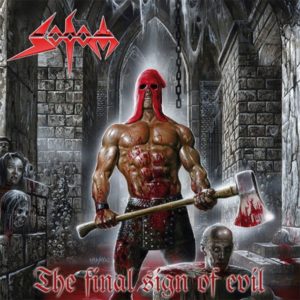
The Final Sign of Evil (2007) starts a curious show of nostalgia that apparently made the band go to the extent of tinkering with the guitar sound so that it would sound more strongly reminiscent of the good old days when they still had a good song or two in their system. This is endearing, but pitiful, because the patterns invoked as a means for the construction of this semblance of classic underground speed metal are not only obvious in their emotional signification, but also so simple at this point of the game that any metal toddler could have come up with them. These issues would be compensated by a mature and more mindful treatment of the songs’ organization as a whole, but instead, we get a retrograde album that makes us suspect if the band members are not senile and mentally devolving.
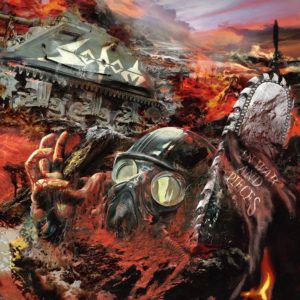
In War and Pieces (2010) abandons the previous attempt at a nostalgia trip and goes back to stomp rock alla Rob Zombie. This time around there is no half-ass cover-up. Sodom is telling us they have “evolved”, trying with all their might to convince us that they have been left behind with the times. The band does this by playing this modernized 90s trailer park heavy metal enhanced by the new millenium’s penchant for unsavoury genre mash-ups. The most annoying part of this is obviously the vocals, sounding embarrassingly close to the posturing of Slayer in Raining Blood. Updated trademark Sodom genericness being an expected blunder that has, by now, become part of the sorry landscape of assimilated metal.
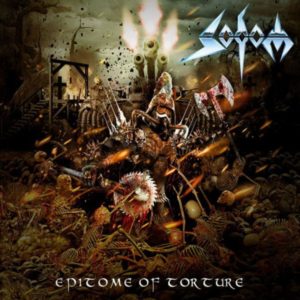
Epitome of Torture (2013) came out when there was a rise in classic bands returning to their roots, some more successfully (Graveland – Thunderbolts of the Gods, Summoning – Old Mornings Dawn, Black Sabbath – 13) than other (Carcass – Surgical Steel). Sodom, for the first time, resisted the temptation of imitating its betters in the underground camp. They decided to stick to their guns and see this ride through mainstream land on their take on nu speed heavy metal to the point of provoking tears of resentment, frustration and painful mourning among the deluded few that hailed their brief window of lucidity as metal classics.
Having gone through Sodom’s progressive decadence one step at a time, from their earliest work to their latest contract-enforced commercial product, has given us the opportunity to appreciate their work relation to their historical contemporaries and prepare ourselves for a better understanding of their latest effort. By giving context to Sodom’s career, we may avoid disappointment, or in the better case, appreciate efforts towards a sincere though tenuous revival in the band’s spirit.
The story of Tom Angelripper and Sodom means more for metal than most realize. Not so much as a result of a direct musical influence to many, which indeed they may boast of according to some people, but because of the stylistic change curve the band’s discography describes and how closely it follows changes in the metal landscape. This is a story of the twists and turns of metal as a whole after its rise in the 80s until its demise as an artistically evolving genre in the mid 90s. It starts with the birth of underground metal, its rise towards the end of the second decade of its existence, its phase of inner turmoil and bifurcation, and finally the big crashing and burning that its assimilation and selling out brought about.
Sodom is a perfect example because it is a prominent band, but it is also the average Joe among metal bands. It is not especially bad, but it is not outstanding either. It is just good enough to be considered a respectable specimen of the speed metal, or as the general crowd knows it, “thrash metal” (a discussion of their distinction was started by Brett Stevens some time ago in a very informative article). This strictly follows Death Metal Underground’s view on the subject of metal history as per its musical and ideological/spiritual evolution. People who do not understand the nature of art detest any mention of a clear mental orientation such as ideology or a particular spirituality in relation to music, but for better or worse, it is an inseparable part of anything remotely meaningful for humans.
Metallica and Slayer were giants in the 80s playing a style which would not sell in the same way today, even if it were new. The reason for this is that they were expressing something that was inherent to the outlook a large section of the young population. Hence, back in the day, it was expected of a proper metalhead to listen to underground styles of speed metal that found inspiration in the vocabulary of hardcore punk rather than the ballads and heavy rock obscenities inspired by Led Zeppelin that glam metal sought to emulate. Exceptions were successful New Wave of British Heavy Metal acts like Iron Maiden, which at the time provided a mid-way approach that did not abandon underground aesthetics while boasting of a pop ace in the form of Bruce Dickinson’s vocal theatrics.
Sodom starts out at the very beginning as a comrade to the most extreme side of underground metal like Venom or Bathory. At the time, this lent a very particular kind of advantage. First, it was a very well-respected niche in metal, even if treated with fearful awe by many, something which the most recent mentality has turned into a joke, failing to comprehend it in the slightest. Secondly, this style allowed for bands with very poor proficiency as technically trained musicians to make a credible musical proposition. A good reason to judge Sodom’s decision to play the raw underground metal it chose to is better explained in retrospect once we have inspected their actions down the timeline viewed in relation to general genre-wide developments and the particular innovations of other bands like Slayer.
Up until 1986, underground metal in the form of speed metal and its more extreme expressions verging on proto-death was carried on the shoulders of bands that were refining their ideas, not only becoming more proficient as musicians but also as songwriters. The first two Sodom albums, however, appear as more of the same, a repetitive take on a repetitive personal style devoid of any unique value. By 1987 the seeds of death metal have been planted by pioneers Morbid Angel, the claims of fans the AIDS-cursed Chuck Schuldiner notwithstanding. It is only after this point that we hear Sodom clearly making a turn towards what is popularly known as “speed death metal”, considered to be hybrid of both genres. In reality, most bands that bare such a description belong to either one or the other genre, but not to both, the ridiculous hybrid tag being born out of commonplace ignorance and plain stupidity.
The Sodom we see before the explicit selling out to mainstream forces was always a speed metal act, however pathetic and short-lived its efforts to cash in on the rapidly evolving phenomenon that grew out of previous underground metal styles. Indications of this desperate clutching can be seen as the band most obviously outreaches itself in awkward gestures during the first few records of the 1990s, rapidly degenerating into a sorry and unrecognizable variation of Panthera’s gutter glam groove metal. The rest has already been discussed and we shall not dwell on it longer. Suffice it to say that Sodom is simply the reflection of metal as a whole, not in its best and most outstanding representatives (who belong to a genre-independent elite of artists more than to “metal”), but in the average knucklehead beer metal desperate to appear tough and following scene trends dictated by “the fans”.
Tags: beer metal, German Speed Metal, germany, proto-underground, sodom, Speed Metal
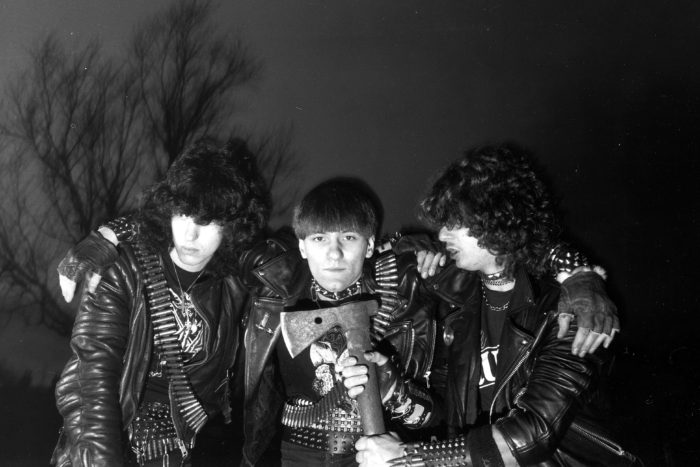
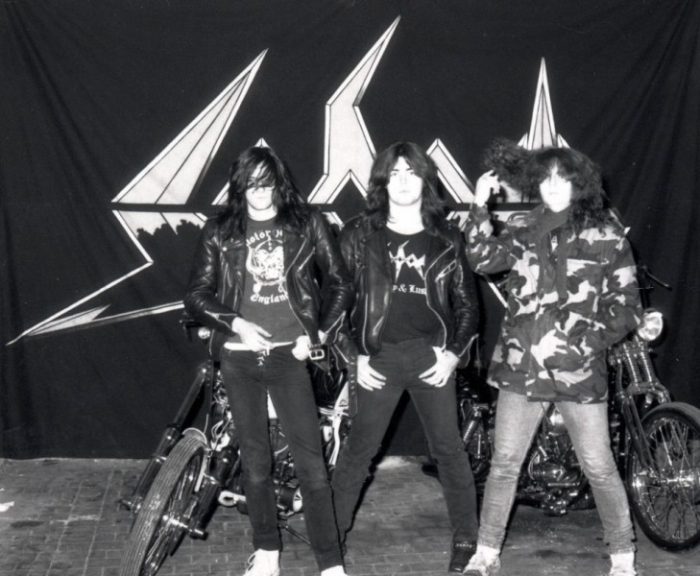
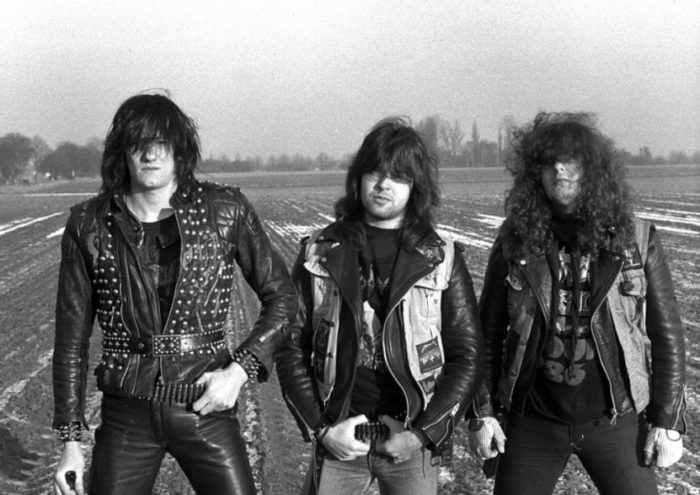


Obsessed With Cruelty is one of those albums that’s either recognized as the band’s deepest and most forward-thinking work (here), or as their most basic release (on metal-archives or p much anywhere else). Some people just hear music with totally different ears.
I get the feeling newer metal fans don’t put as much thought into how songs are put together, why a riff hits you the way it does, etc. For them, “atmosphere” is just a bunch of signifiers like owl noises, and being “progressive” is about cheesy Mr. Bungle-esque idiomatic contrasts.
Well fuck that. Early Sodom is atmospheric, progressive music that happens to sound like sewage.
Mainstream metal fans refuse to admit that the best song on Persecution Mania is Motorhead’s “Iron Fist”.
And that its execution is better than the original, in my view at least.
Yep. Versus the old school fans who would thoroughly digest any new release!
That approach to listening doesn’t allow for the 10 CDs a week in the mail buying habits the distros and labels want you to fall into. I do find it funny the label heads insist there is no money in metal but then post pictures of their new houses and 17 vacations a year on fartbook while bragging about not having a day job. Meanwhile touring bands from Europe are borrowing gear from local openers and touring in a tiny car rental paid from their own pocket in the states. Not my problem but heh..
Creating an abstract ‘map’ of some track in order to get an intellectual grip on it isn’t everybody’s cup of tea, not the least for want of suitable, descriptive terms. Even insofar descriptions can be made up, eg, one of the Great Is Our Sin tracks has a part where the guitars are playing ‘breakdown stuff’ with the drums running light-feetedly ahead of that, something I consider highly amusing because it would leave a lot of people who very convinced of their rockin’ badassness completely confused wrt what to do now, do I gain anything by describing this in words minus to opportunity to get knocked on the head with an “anlog post-germanium tube diode?”
Persecution Mania is Sodom’s peak. Agent Orange accentuates the bouncy rock music latent in the former (but kept mostly in check) to a greater degree, despite better production.
I agree, and would add that their earlier work was vital in establishing underground metal.
Brett, sidebar to that: it would be super interesting to read an article on DMU about the listening habits of the Old School (i.e. pre-Internet). Specifically how you guys developed contacts in the underground, got zines, traded bootlegged tapes, how many records you were getting each year, logistical shit like that.
Thank you!
What I miss the most from the days of yore is writing and recieving handwritten letters with attached mixtapes, etc.
How were you developing contacts?
Like, I’m imagining I’m 15 in New York in 1988. How do I get from that to hearing, like, Bathory? How am I getting the zines from Europe ‘n shit?
I encountered Kreator before Sodom as Sodom was considered a bit of an overdone joke, not the least because of the vocals. Persecution Mania certainly doesn’t sound like anything Kreator ever played in the 1980s, especially not vocally (although the guy who fucked up the guitars on Obsessed by Cruelty probably appears as second guitar player on Pleasure to Kill). In retrospect, Kreator has (this is also visible in the lyrical topics) a strong influence of aggressive punk instead of the more laid back Motorhead, Tank and Thin Lizzy lineage.
Persecution Mania is certainly »the« Sodom album, Agent Orange being a lame rehash of that and Better Off Dead fizzling out on all kinds of tangents. I suggest Christ Passion/ Procession to Golgatha as best track. Nuclear Winter is also quite cool as is the Motorhead cover. And the last track, of course, which ends with the Kaiserquartett theme[*] on lead guitar evolving into noises, followed by a fadeout, some laughter and “Komm, gehn wir einen trinken!” (not audible in the youtube version, “Let’s have some beers”).
[*] Written by Haydn. It used to be the Austrian national anthem in imperial times (“Gott erhalte Franz den Kaiser”) and is also used as music to Hoffman v. Fallersleben’s “Lied der Deutschen” whose 3rd stanza is still the German national anthem.
Good article, I feel like this could have been even longer and more detailed. It’s an interesting format and I hope you try it with other bands later on.
I always felt the same that this was a band that just followed trends.. The first three Sodom albums are great and worth returning to year after year, I fucking HATE Agent Orange as it is the most flat generic plead for credibility and most boring album ever made. The rest have sings here and there but I’ve given up digging in their discography, too much bar chick punk and homie slams. This and The Misfits articles were really good, I agree there should more like them.
That 1987 photo of SODOM at the bottom you posted, (left to right) with Tom Angelripper, Frank Blackfire, + Chris Witchhunter, Every time I see it I think that is Terry Sadler from SLAUGHTER instead of Blackfire who joined Sodom!
:D
yeah, they peaked with Persecution Mania …
and you guys don’t hear the “Code Red” album is just their attempt at bashing out some Reign In Blood-type thrash ?
Everything by Sodom is shitty, nd their peak in Persecution Mania is lukewarm and full of second and third hand ideas.
A great article. In the Sign of Evil/Obsessed by Cruelty have historical significance but the songs contain a lot of ‘catchy’ repetition which can grow tiring after repeated listens – this is very noticable on the In the Sign of Evil EP.
Persecution Mania is where Sodom reinvented their sound and is their most interesting work. Agent Orange is a rewarding album if you listen to it in the same context as you would a Motorhead album, it’s a more mainstream sounding album but it has less extraneous parts as it is better edited than previous works.
The next 2 albums are mostly forgettable, I havn’t bothered to listen to any after that.
Nice article, but there is a mistake in it: “Victims of Death” from 1984 is the second demo. The first is “Witching Metal” from 1982.
In the sign of evil was great in a simplistic, sloppy chaotic kind of way much like Hellhammer. I guess it helps that it’s a short EP. There’s no denying the significance of tunes like Blasphemer, Witching Metal and Outbreak of Evil. Obsessed by cruelty has gems like Deathlike Silence, Proselytism real, pretenders to the throne and the title track. It also has filler tracks as well but, still a strong effort overall. Just not quite as good as pleasure to kill or The Return…
Persecution Mania is where Sodom peaked. Their finest full-lengh. Tracks like Nuclear Winter and Christ passion are one of the better examples of the genre. Agent Orange was a good album as well even though it’s a bit more polished than it’s predecessors. I just didn’t like the hippie like anti-war message on that album. They started regressing but, agent Orange is hard to not enjoy. Better off dead had it’s moments but, I’ll hit skip button a few times whenever I play it. The saw is the law and capture the flag are cool tunes, but at that point Sodom’s best days were behind them. Didn’t bother with anything they did after that except the final sign of evil which I bought and played a few times, but has collected dust ever since.
I always considered Kreator and Destruction to be a tad bit better than Sodom.